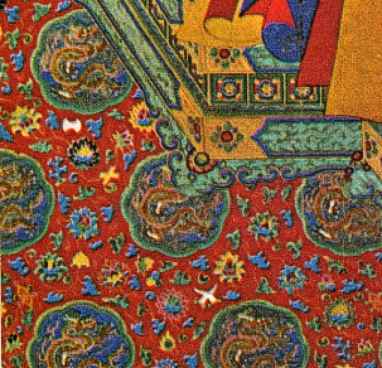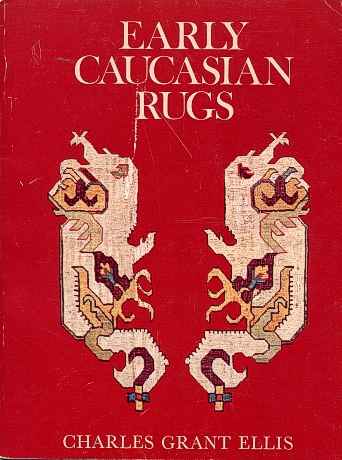
OK, better late than never I suppose. I have borrowed a copy of the Ellis book, Early Caucasian Carpets. And while I believe we’ve pretty much agreed to discuss the 19th century carpets that I believe are emblematic of Caucasian design, there was much that interested me about the dragon rugs and other “classical” designs.
First – a note of this work. I fear I agree with Marla about this. The writer is constantly referring to this or that as “degenerate”, badly drawn, so forth; nor does he place the production of these carpets within a serious cultural context. Also, it appears that he believes, since these are carpets, they must have a precedent within the realm of carpet art.
This is the kind of writing that drives art historians – and serious students of esthetics – not to mention formalists – absolutely nuts. It is judgmental and misleading.
Nevertheless, the pictures are nice. And I appreciate Michael’s recommendation that I read this – as it’s reinforced some ideas I’ve been kicking around in my head, and given rise to new ones.
And so - back to the carpets.
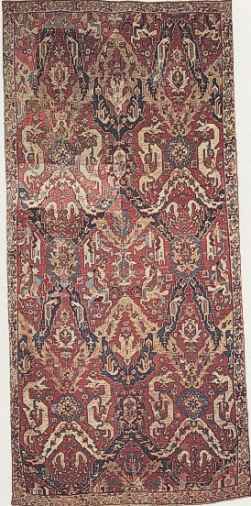
I’m going to present a theory which I have arrived at independently – like this morning; but which I am gratified to report, has other adherents in the form of Wertime and Wright. That is the notion that the dragon rugs may have had their inspiration in the embroideries of the region; I’m going all the way back to China to for my examples.
Secondly, I’m going to speak about two alternative theories, each of which has considerable merit:
1. As Gantzhorn argues vehemently, these carpets are of Armenian manufacture and were made IN ARMENIA, specifically from the region of Van. They follow not a Persianate, but a “Turkic” design idea.
2. The carpets were of local design and manufacture, and drew upon local embroidery AND FLATWEAVE ideas, which I shall illustrate.
Finally, it must be mentioned that some writers argue these aren’t Caucasian carpets at all. But I think they were most probably made in that region, or close by, for the reasons stated above, and others that I will try to explain later. However, my primary argument is both formal, in the context of visual design; and historical, in the context of the extraordinary impact of Chinese culture upon the Asian world.
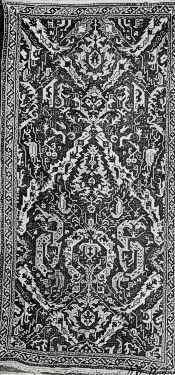
Now – let’s start with the Persian Vase Carpet theory. First, IF they were made by Kirman weaving master does it follow that they also drew them up? Why would a workshop have been established in the Caucasus? And, visually – in formal terms –don’t they appear WAY too strikingly different from the Kirman carpets to which they are presumably related? Don’t forget – these are essential contemporaries of the Kirman pieces and were presumably made during the same era.
Ellis says, “Evidently the original dragon rug cartoons were based upon a lost group of Kirman rug designs that were closely allied to the vase carpets, but which contained many animal forms. A solitary fragment of one of these South Persian carpets is known to survive. . .” It is most convenient of these “ancestors” to have been lost.
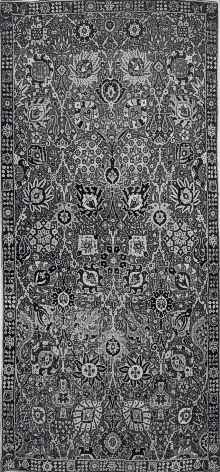
The above is a “typical”, according to Ellis, vase carpet. I do hope Ms. Beattie has not excluded this one from her definition of the type.

And this one is the so-called “ancestor” of the dragon rugs. Well, at least, as Mr. Ellis points out, one CAN discern a little animal and perhaps even part of a Chinese-style lion. And perhaps, he has a fantastic sense of humor?
And he DOES admit that the dragons and other animals on the “Kuba” carpets – apparently the oldest dragon carpets - were drawn (albeit, he says, at second hand) from the arts of China. But I’m not talking about the animals themselves: I’m talking about the very FORM taken by the carpets.
At this point I want to quote a maddening statement by Ellis, which I believe is TOTALLY unfounded (and, folks, IT CAN’T BE PROVEN. Which should have made you dudes really, really mad – but I digress):
“Inventiveness seems not to have been a characteristic of these Caucasian designers. It is the boldness and vitality of their geometric adaptations of curvilinear designing that have blessed them with the impression of novelty. Usually the models have been Persian types. . .”
I’m arguing, as I have throughout this discussion, that the very boldness and geometric quality of the Caucasian rugs IS their design; further, that they drew not only upon OUTSIDE influences, but upon their own flatweave and embroidery ideas; that there was no such thing as a GOLDEN AGE of carpets, as Ellis asserts; but rather that wonderful pieces – like paintings – can be produced and have been produced in any era, from the caves until today. Regardless, I believe, whether or not a weaver, be she a tribal weaver or be he a workshop designer, the carpets of this region ARE inventive – they invented a new and distinct design of their own.
But let’s get back to work.
Don’t you think it’s far less of a stretch – and an obvious visual connection to people with a background in Asian art - to consider that their immediate inspiration came from Chinese or Chinese-inspired brocades and embroideries and other art, such as paintings and porcelain, and possibly including carpets? Or even, that they were locally designed and made, perhaps drawing inspiration from Caucasian and Kaitag embroideries and the flatweaves of Anatolia and the Kurdish people?
I feel strongly that either of these two ideas, or more likely a combination of the two, is responsible for the design of the early dragon rugs AND the so-called Sunburst carpets, which we will also discuss.
This isn’t just because of the presence of dragons and other animals that, as Ellis properly notes, did appear on Mongolian and Chinese embroidered badges. It is also a matter of the drawing, the shapes, and the way the forms interact with the space around them. Of course they are not as fluid as the embroideries but they show many similarities in concept AND in design details, particularly with Ming Dynasty work.
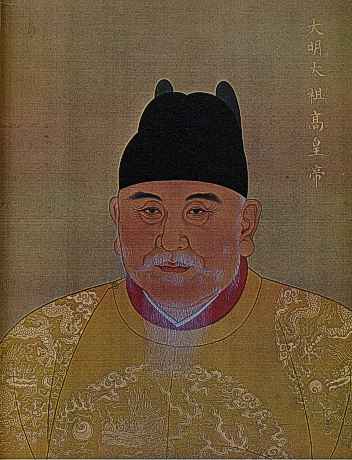
Here is a portrait of the Emperor Hung-wu, who founded the Ming Dynasty in 1368 C.E. He was a pauper, born Chu Yuan-chang, who entered monkhood at the age of 16 when drought, locusts and epidemics killed his parents and oldest brother. Unfortunately the temple where he’d sought refuge ran out of food and he left with an alms bowl, wandering and begging for the next few years. He joined a secret cult during this time, which prophesied the rebirth of the Maitreya, or Future Buddha, as “Ming Wang”, the Brilliant Ruler. Called the White Lotus society, this sect was apparently a fusion of Manichaeism, which worshipped light against darkness, and the Maitreya Society – which believed a sage would come from heaven and rescue the suffering masses (sound familiar?). It had been repeatedly banned by the Mongol regime, and had gone underground to become a center of resistance…
The resistance in this case was against the Mongols, who had ruled China from C.E. 1279-1368.
Note: Here and throughout this brief history I am paraphrasing extensively from an excellent art/history book, “China – A History In Art”, by Bradley Smith and Wan-go Weng. I’ll list this book, along with many others, in the bibliography that I’ll append to this Salon.
The importance of China to the world at large cannot be underestimated. Particularly during a period when the West was living through medieval times, Chinese scientists made or advanced several inventions that, in Frances Bacon’s words, “changed the whole face and state of things throughout the world.” In the 350 years preceding the Mongol invasions, the period in Chinese History called Five Dynasties and Sung – from C.E. 907-1279 – printing was advanced to include the invention of movable type in the 1040’s. As Smith and Wan-go Weng point out, “this innovation took place four centuries before Gutenberg.”
Secondly, gunpowder: “Taoist alchemists acquired an early knowledge of gunpowder and pyrotechniques through experimentation with sulfur and saltpeter. Firecrackers were known in the sixth century C.E. and a Chinese military handbook compiled about 1042 recorded the formula for preparing explosive powder in making ‘fire balls’. . .By the thirteenth century, the Jurchen were employing this ingenious agent of destruction against the militarily superior Mongols, who lost no time in improving it for attacks on Chinese strongholds.”
“…the same 1042 military handbook described the making of a floating south-pointing fish from thin iron leaf…” – the invention of the magnetic compass, about four centuries before “the discovery of declination traditionally attributed to Columbus in 1492”. Sea travel was allegedly extensive, with large ships carrying “hundreds” of people.
I wonder - could it be that a Chinese ship reached the west coast of Mexico during this time? I think it’s certainly possible but it’s only speculation. However it would explain the veneration in America of those pesky dragons.
“Sung was also a time in which works on mathematics, astronomy, meteorology, geology and mineralogy (with references to fossils), geography and cartography (including the making of relief maps), biological observations and a host of other subjects.” (note – in a book by Shen Kua). High-quality books were published on the subject of botany and zoology and pharmaceutical plants. Scholarly physicians codified traditional systems to pharmaceutics and acupuncture. To intensify cultivation and expand the area of arable land available to support a greatly increased population that probably exceeded one hundred million, irrigation and hydraulic engineers made great strides in lockgates and new surveying instruments…metallurgical processes in gold, silver, copper, iron, lead, tin and mercury were highly developed.”
Finally, “the making of porcelain, which began in T’ang, became fully refined in Sung.”
Gradually, a picture emerges of powerful, culturally gifted China to the east, the Ottoman Empire, Russia, Persia and India – and of course the Mongols and their descendants and neighbors in Central Asia, all playing a role in Caucasian life, commerce and art. And, it must be remembered that resident Jewish and Armenians as well as Islamic Arabs must certainly have played a part.
Here, for fun – and because the Mongols are so important to the history of carpet-making people and of course, carpet lovers – is a contemporary Chinese portrait of Kubilai Khan:
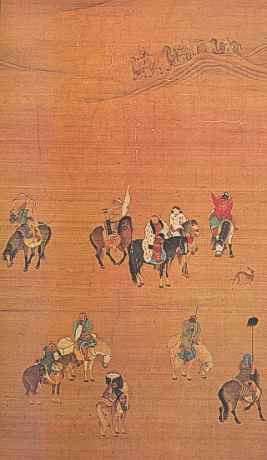
Note the camels in the background. Perhaps they’re a caravan, enroute to Persia or the Levant. Perhaps they’re going to drop off some goods in Kuba or Shirvan? And note the Mongol horseman in the foreground with a pole surmounted by a horse’s tail hair: this method of identifying military units and sending signals during battles has been noted by Viennese historians, when they were besieged by Suleiman during the apogee of the Ottoman Empire (ref. “Lords of the Horizons” – another work I’ll list for you).
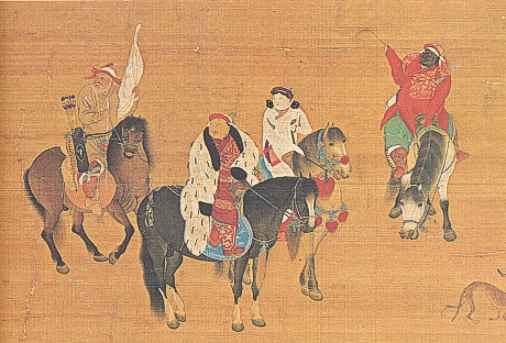
Here’s a detail. Kubilai Khan is the man in ermine. He was of course Jenghis Khan’s grandson. He “became the first foreign ruler of all China, adopted the Chinese dynastic name of Yuan and reconstructed Peking as his winter capital.” I get a big kick out of seeing a person like this in a painting made during his life. In fact, this is probably one of my very favorite paintings, ever.
At this point I’d like to insert a brief history of the Mongol Empire, since it is of such great importance to the study of Oriental rugs.
Quoting Smith and Wang-go Weng, “The Mongol Empire began at the northern fringe of Chinese civilization. On the upper reaches of the Amur, Temujin built his power from a handful of followers to become Jenghis Khan (the ‘Emperor of the Seas’). . . to his enemies, surrender meant life and resistance meant death. To the talented, he offered high posts and generous compensation without regard to race or origin. He united the diverse Mongol tribes for a single purpose: to defeat their enemies and share their treasure.
“. . .The striking force of the army came from its hard-riding horsemen, capable of covering long distances at great speed.
“…In a final campaign before his death in 1227, Jenghis Khan destroyed the His Hsia and took over much of the Jurchen land in North China. He overwhelmed the Kara-Khitan Empire in Central Asia, and captured the Turkish empire of Khorezem east of the Caspian. But he gained far more than territory: he acquired the service of Chinese generals and administrators, Moslem merchants and financiers, Turkish warriors and Uigher scholars, who adapted their script for a Mongolian written language. Thus, with some 130,000 warriors and a population of only a million, Jenghis Khan laid the foundation for the Mongol Century.
“During the second phase of conquest, through the reign of three successive Khans lasting thirty-three years, Mongol armies triumphed over Persia, Mesopotamia, Armenia, Georgia and the Abbassid Caliphate at Baghdad. Westward they crossed the Volga, took Moscow and Kiev, penetrated Poland, Bohemia, Hungary and the Danube valley, and reached the Adriatic Sea . . .The final conquest was accomplished by Jenghis Khan’s grandson Kubilai Khan. . .as . . . Marco Polo later observed, the Khan had no confidence in the (Chinese) natives; he put all authority in the hands of Tartars, Saracens or Christians. . .”
Finally, with the death of Kubilai in 1294, the tide of the Mongols began to recede.”
OK – back to the rugs.
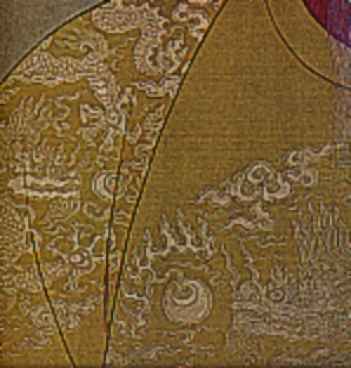
This is a detail of Hung-wu’s silk robe. Lest you’ve gotten confused, Hung-wu was the first emperor of the Ming Dynasty – it was he who took back the rule of China from the Mongols. It’s difficult to see because it’s embroidered tone-on-tone – but to my eye the form, the types of shapes and they way they interact with space, is much more similar to the dragon rugs than the dragon rugs are to Persian rugs. This is something I hope to investigate further – perhaps some of you would be interested as well. Marla has a few pieces on her website; here’s another one:
http://www.asianart.com/textiles/dragbadge.html
I apologize that I don’t have a better scan available. I don’t have any of these in my collection and as I said, I just got this idea today.
I’m sure a search of the 'net would reveal many others. For purposes of comparison, here’s a fragment from the Ellis book, Plate 2. I’ve used this fragment deliberately. When you see it as a design, liberated from its carpet-being, it can be more closely compared to the embroideries.
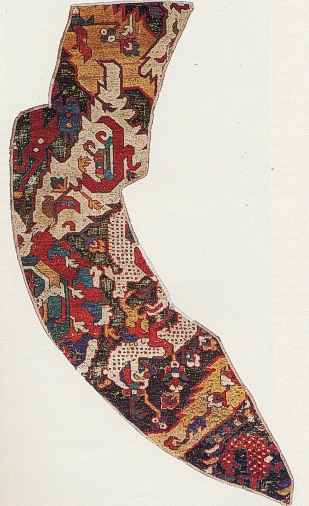
Incidentally, as I mentioned, I was pleased to read that Wright and Wertime agree with this hypothesis – although they don’t believe ANY design transfer necessarily took place - “…a medium (for design transfer) is readily available in the form of silk embroideries which have design affinity with both the dragon and floral carpets…” (W&W, p. 27 – I’ll list this book in my bibliography also.) They go on to assert that this women’s craft had been practiced for many, many years – centuries, perhaps – in the region.
W&W also feel that the “classical” carpets (i.e., the ones in Ellis’ book, etc) are not firmly a part of the textile canon of Caucasia. This idea too, deserves respect and further research. It does seem as if the more abstract and purely geometric form took over; as I’ve mentioned, I believe this is the “fully evolved” form of Caucasian carpets (and – need I say again – NOT a degeneration from ANYTHING – but a true expression of Caucasian design).
I have made some scans of Central Asian embroideries that I do happen to have. If you’ll look at them, not with an eye toward their motifs or “subject matter”, but with an eye toward the SHAPES that are formed by the interaction of the embroidery with the SPACE around them – see how basic this is? – you will, I believe, note some similarities with the forms revealed in the dragon as well as the “sunburst” carpets. The oldest is probably mid-19th century and the youngest, early 20th. Nevertheless they illustrate the continuing vigor of this art form and, I believe, still show the design ideas relevant to those old carpets.
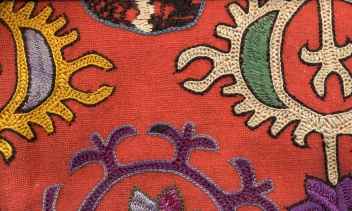
Here’s an early 20th century piece from Central Asia.
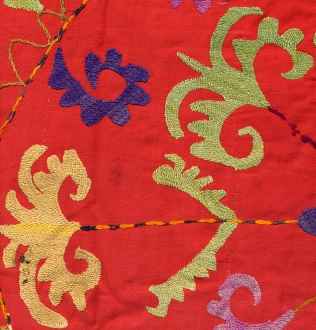
Here’s a Kirghiz horse-cover, presumably a bridal piece. The fabric is a fine red silk.
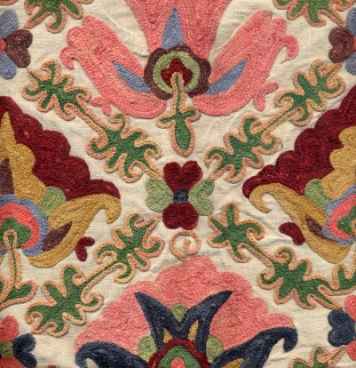
Now here’s a suzani from Bokhara. I believe this is Lakai. This one shows an idea that one can clearly see in the sunburst motifs which I’ll illustrate below. In fact, if you use your imagination, you can see how the whole medallion might have been designed, first in a simple form and eventually becoming more and more elaborate and exuberant.
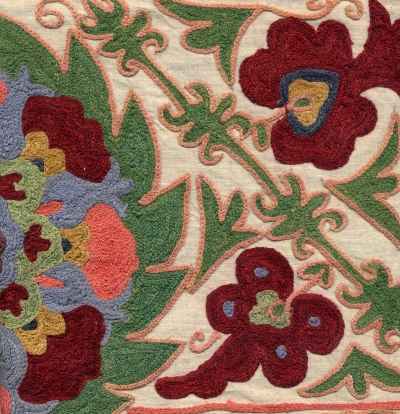
This is a scan from the same suzani. Look at the white shapes – yes folks – the NEGATIVE SPACES – and you will see the alternating smooth and jagged edges that Ellis says are characteristic of the dragon ones – and which he believes evolved from Persian rugs(?)
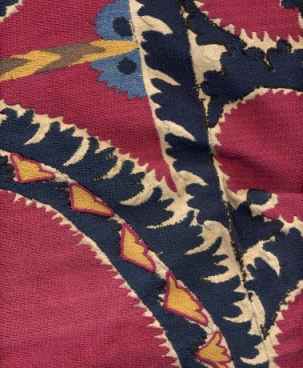
Now, just relax and contemplate, again, the shapes and spaces created by the design of this scan of an old Tashkent suzani.
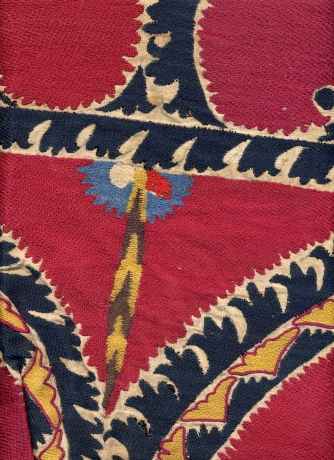
And here’s another view. I’m also including two links where you can study Caucasian and Kaitag embroideries – also, I believe, a possible source of inspiration for Caucasian carpets.
http://www.kaitag.org/
http://www.textile-art.com/tc96.html
Beyond this idea, you will find, if you study Gantzhorn’s book, the theory that they were made by Armenians – in ARMENIA. His argument is quite persuasive. This is the other argument I will set forth and illustrate below.
So, the attribution of these old carpets to the Caucasian region is, as W&W assert, “more likely to be no more than spurious”, let alone the assumption that they derived from Persian “vase” carpets.
But what, you might ask, of the idea that the embroideries derived from the carpets and not the other way around? Well – given the sheer number of women who have practiced this art, and long-lasting nature of it – I would say THIS is the vital, seminal art form – and not that of the “classical” carpets – which do not seem to have lasted long or taken deep root either in the Turkish (Armenia) region or in the Caucasus. And I don’t think they’re Persian. So we have to give primacy to the form that did last and was demonstrably visible much earlier – in Chinese form – than the carpets themselves.
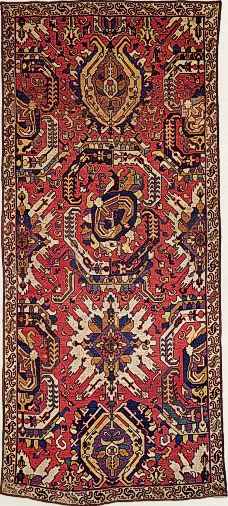
Meanwhile, back to the carpets. Here’s a rug flaunting what Ellis refers to as “sunbursts”. Now these definitely resemble the Chelaberd medallions about which much has been written. Scaled up to the point where they would dominate the space around them, they would certainly seem to provide a link to the 19th century rugs – thank you, Christoph! Now – where this medallion originally came from – again, I feel far more comfortable suggesting a Chinese origin or even a Central Asian origin – perhaps – why not – even a LOCAL origin; and feel this point too, deserves research. Look back the embroidery – particularly the Bohkara suzani. Or – perhaps they even had an ARMENIAN or Anatolian origin. Here’s a detail so you can see it more clearly:
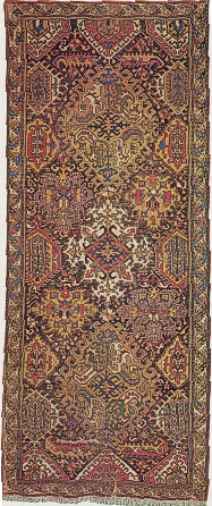
Again, the interaction of form with space doesn’t strike me as being at all related to Persian rugs. This is much more of a positive-negative sort of interaction, of the type one sees so powerfully rendered in flatweaves, and which can be seen too, in some of the fabulously expressive needlework produced in Central Asia and in China.
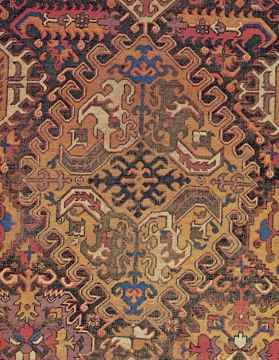
Now this one shows an amazing hook-type spatial interaction of the kind seen in kilims! Here’s a detail of an old Kurdish kilim from Anatolia:
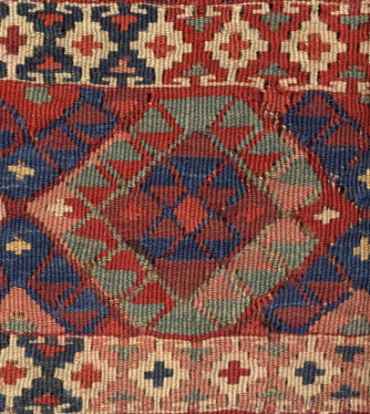
And here we see another Kurdish example, this one from a pile bagface clearly imitating the kilim idea:
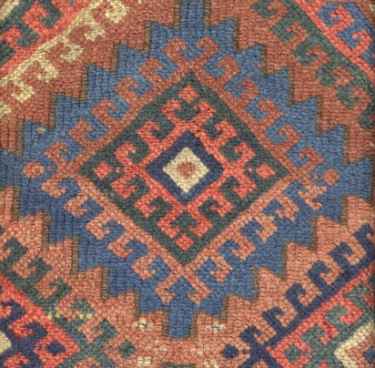
And here’s another one, seeming to indicate very clearly the embroidery idea:
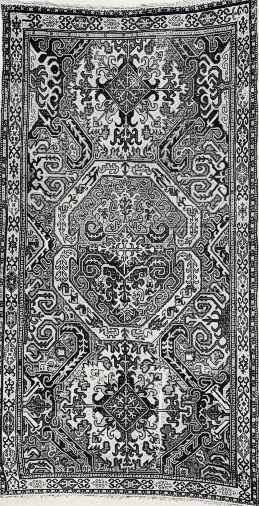
These seem clearly to indicate other design ideas at work – ones coming up from the weavers and embroiderers to the designers and not the either way around. And again – it’s a design idea from a much older tradition and one that remains vital – not degeneration from a “classical” form.
In fact, I’m beginning to think we should start thinking about which is the “classical” form and which is the – well – manneristic. Self-conscious. Overly decorative. Look up “mannerism” in your art history books – you’ll see it’s an attenuated form that evolved out of the High Renaissance – SOME people might call it “degenerate”. My friend Sam Gorden certainly thinks so. I can refer you to some of his writing or make some direct quotes if you’re interested.
Modernist thinking would surely consider the Persian “classical” carpets a degenerate form, because they have nothing to do with weaving! This is an esthetic concept, probably epitomized by Mies van der Rohe, which stated
1. Form should follow function
2. Less is more and
3. Honesty of materials is paramount. In other words, steel is steel and should be expressed as such. Weaving is weaving and should be expressed as such, in forms that honor and express the medium – i.e., GEOMETRIC forms, and not the filigree complexity and naturalistic drawing of the Persian “classical” carpets.
So perhaps the lowly tribal and peasant weavers are actually the classicists of the loom.
I, however, do not believe in being dogmatic. So we’ll leave it here – something for you traditional “classicists” to nibble on.
Now, here’s another example of a sunburst rug, from Gantzhorn’s book:
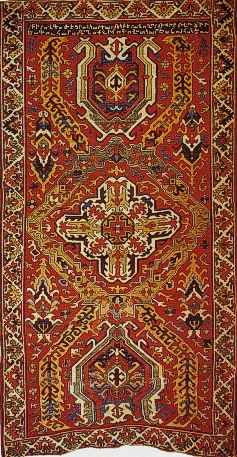
He argues that these are in fact ARMENIAN rugs, incorporating STAR-CROSS motifs, which over time evolved into the Chelaberd rugs we see today. Far from being evolved from Persian Vase Carpets, these symbols are, to Gantzhorn’s mind, exuberant symbols of Christian mystery and joy. In his estimation, an early model for the Eagle Kazak was this, the Gohar carpet.
It is dated 1680 C.E. and has an Armenian inscription, which states “I, Gohar, sinful and sick in my soul, made this carpet with my own hands. Let anyone who reads this pray for me that I might be forgiven. 1129 (AD/1680)”
According to Ganzhorn, this carpet, pictured on page 350 of his book, which I’ll list in my bibliography (thanks again, Pat!) is a votive gift – to a CHURCH. It is not Persian. It is not even Islamic.
And look at this:
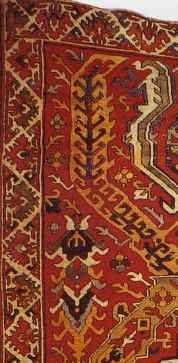
Notice the border design. Don’t these resemble Anatolian kilim ornaments? Perhaps they are even Elibelinde-types? Certainly, they do look a lot like kilim designs from Van – the very region Gantzhorn asserts created these rugs. What a marvelous juxtaposition!
Here’s another:
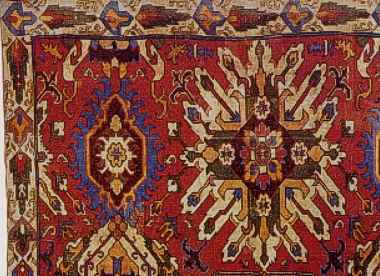
This detail shows a very floral expression of the star-cross medallion; in fact, if you’ll check back to that Suzani I think you’ll see some very similar forms. Also, note the “dragon claws” in the border – very expressive forms that appear to relate to embroidery rather than to pile carpets.
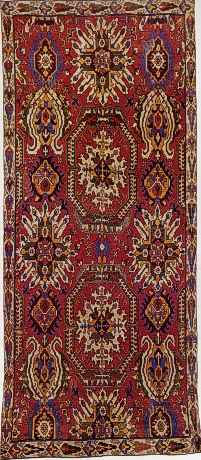
This is the fullscale rug, clearly indicating not one – but TWO – star-cross/sunburst flower ornaments: the one more heraldic, the other more floral. Both can be seen, if you open your mind, as eagles, or even angels, flying against the sun.
Purely for the sake of argument – let’s for now assume that these and the dragon rugs WERE made in the Caucasus. In that case, I think – as I mentioned in my original thesis – the very look of these rugs does argue for a truly Caucasian design type. Not in the details – now, look instead at the design – the shapes, colors, the overall boldness and geometric nature of the design – whatever motifs and design inspiration there may have been, have been absorbed into and transformed into a new design type. If we can look back from a distance, removed from the heat and conflict of our recent discussions, we can clearly see that these pieces – old as they are – are much more reflective of Turkic and, I think, Chinese design ideas than they are Persian. And, they came in time to be associated with Caucasian rug design.
Whether the “classical” pieces were made in Caucasia or not, it’s clear to me that the Caucasian rug industry – the weavers and designers – absorbed and transformed these pieces along with their highly symbolic motifs of dragon and garden, cross and star, into a new design form.
Of course – if there were even older rugs from the Caucasus – this too is arguable and I believe quite possible, probable even. As was pointed out in Daniel’s recent Salon, just because all the rugs seen in paintings and so forth were cataloged as “Turkey” rugs doesn’t mean some of them didn’t come from the Caucasian region. And, I would argue for a powerful flatweave tradition. Look at what I think are the fully-evolved Caucasian rugs – those of the 19th and early 20th centuries. Regardless of the rich design pools they may have drawn upon, these are so distinctive they’re being copied from Romania to China. This is a style so stunning and powerful and so clearly its own thing that even Turkmen are copying them. People love them, they will buy them, and the Caucasian form will last, I think, a long time. It is truly “modern” art.
Here, on the other hand, is a rug much more clearly influenced by Persia, as are many to be found in the Eastern part of the area, that overlaps with Northwest Persia:
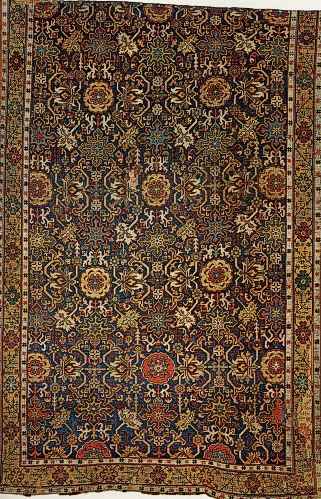
Even so, even though it’s much more finely drawn than most of the dragon rugs, this piece is still a bolder, more abstract statement than that made by most of its southern, let along city or court! - counterparts. It’s just more angular, more robust. And the Afshan design as it evolved into the 19th century, again, became truly transformed into a new design:
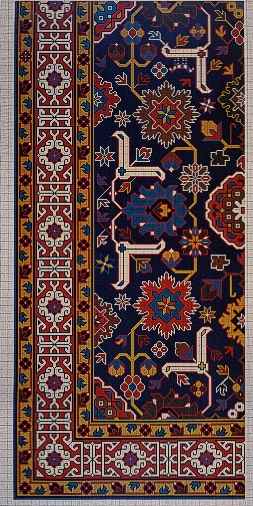
Finally, I’m including yet another reference to China – this is just too interesting, especially for those of us who love Turkmen art as well as Caucasian.
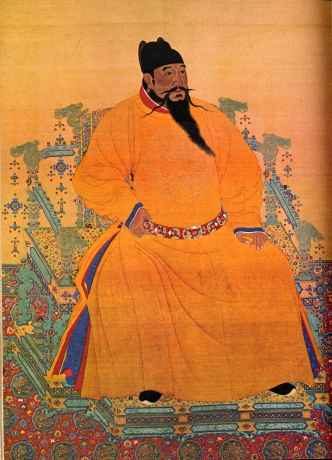
This is a portrait of the Ming Dynasty emperor Yung-lo. During his 22-year reign, he led five expeditions into the heart of Mongol territory, first defeating the eastern tribe, the Tartar, and then the western tribe, the Oirat. I mention this because, if you will look at this detail of the carpet at Yung-lo’s feet, it definitely raises some questions:
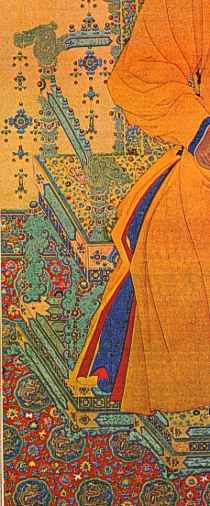
Is this a Chinese carpet? Persian? A very early Turkmen? Also note the dragons and the cloudband forms on the throne – so evocative of the Central Asian art they inspired. A magnificent painting, capturing not only the force of the powerful Emperor, but also many details of other Chinese arts of the time.

And note: the figures inside the guls, are dragons. Could they be the precursors to the Turkmen birds?
